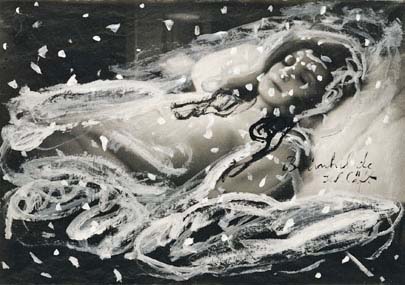Surface Tension
dal 5/6/2002 al 6/10/2002
Segnalato da
5/6/2002
Surface Tension
Harvard Art Museum Busch-Reisinger, Cambridge
Works by Anselm Kiefer. Nine photographically based works, primarily from the 1980s. The works include early gouaches, lead-and-photographic works, and a large book of photographs reworked with ash and acrylic. Kiefer is best known for his monumental mixed-media canvases, which address Germanys fascist past as well as other themes from history, literature, and mythology.

This exhibition of nine photographically based works, primarily from the 1980s, is drawn
from the collections of Los Angeles
philanthropists Eli and Edythe Broad
and the Harvard University Art Museums. The works include
early gouaches, lead-and-photographic works, and a large
book of photographs reworked with ash and acrylic.
Raised in the Black Forest region of postwar West
Germany, Kiefer (b. 1945) is best known for his
monumental mixed-media canvases, which address
Germanys fascist past as well as other themes from
history, literature, and mythology. He attended the Art
Academy in Karlsruhe and later studied informally with the
German artist Joseph Beuys in Düsseldorf. His work has
been exhibited widely in Europe and the United States.
Photographs as raw material Kiefer began to use
photography in the late 1960s while still a student at the
Art Academy in Karlsruhe and continues to use it today.
The photographs he produces, however, are not ends in
themselves, but raw material, incorporated into virtually
every aspect of his work. Kiefer has an ambivalence
toward photography. He acknowledges being drawn to the
photographs depiction of reality but is at the same time
compelled to efface that depiction by forcing his
photographs into unlikely combinations with an array of
contrasting materials, said Laura Muir, Charles C.
Cunningham, Sr., Assistant Curator of the Busch-Reisinger
Museum and organizer of the exhibition. His characteristic
layering of themes from literature, history, and mythology
is thus accompanied by a conflict between media. This
exhibition explores the particular beauty and meanings that
emerge from that conflict. The exhibition begins with an
issue of the Cologne art journal Interfunktionen in which
Kiefer, in 1975, published a sequence of staged
self-portraits titled Occupations, 1969. One of his earliest
photographic projects, this confrontation with Nazi
symbolism paved the way for much of the work he would
produce over the next decades. From these
black-and-white reproductions the exhibition moves on to
two gouaches-works from the early 1980s in which Kiefer
combined his own photographs with applications of acrylic
paint and other materials. These include a work from a
series dedicated to the Russian futurist poet Velimir
Khlebnikov (1885-1922), For Khlebnikov: Little Mailed Fist
Germany (1980), based on an enlargement of a 1969 studio
self-portrait. The unsettling effects of Kiefers wildly
expressionistic application of gouache over the
photographic image accompany a wry commentary on
contemporary events. Kiefers longtime interest in alchemy
and in effecting his own transformations by bringing raw
materials (like gouache and photographs) into contact with
one another found new expression in the late 1980s, when
he began to pair lead with photographs. This combination,
which evokes the first miracle of the alchemical
process -when dull lead is transformed to brilliant
silver- derives its force as much from the similarities
between the materials as from their differences. Their
variations on the color gray and the sheen of their
surfaces produce a kind of metallic harmony, while the
conflicting intangibility of the photographs and the
physicality of the lead produce a kind of tension. The
group of five lead-and-photographic pieces presented in
this exhibition (all from the Broad collections and weighing
approximately 300 lbs. apiece) will include Euphrates and
Tigris (1986-89) and On the Rhine (1968-91). For the
latter work, Kiefer mounted two photographs (including an
enlargement of a 1968 self-portrait) to a sheet of lead.
Kiefer also draws on the symbolism of his materials. The
romantic evocation of the river that symbolizes the German
nation is undercut by the knowledge that lead and water
can be a poisonous combination.
Since the late 1960s the handmade book has been an
important artistic vehicle for Kiefer and one that has
almost always incorporated photographs. The most recent
work in the exhibition is the Busch-Reisinger Museums The
Heavenly Palaces: Merkabah (1990), a massive book of
photographs reworked with acrylic and ash. The gradual
physical transformation of the photographs forms a
tangible counterpart to the mystical journey that inspires
the narrative structure of the piece.
By presenting a range of Kiefers work with photographs,
the exhibition offers an opportunity to not only examine a
less familiar side of this important German artists work, but
also consider it from a new perspective. The exhibition is
accompanied by a fully illustrated brochure (free to
Museum visitors).
The photographically based works in the exhibition will be
supplemented by Kiefers early oil on canvas diptych Head
in the Forest, Head in the Clouds, 1971 (lent by the Broad
Art Foundation), which will be on view in the adjacent
gallery. This exhibition and the accompanying publication
are made possible by the Hildegard von Gontard Bequest to
the American Friends of the Busch-Reisinger Museum Fund.
Busch-Reisinger Museum Harvard
The Harvard University Art Museums 32 Quincy Street Cambridge, Massachusetts 02138
HOURS:
Monday through Saturday from 10:00 a.m. to 5:00 p.m. Sunday from 1:00 p.m. to 5:00 p.m



